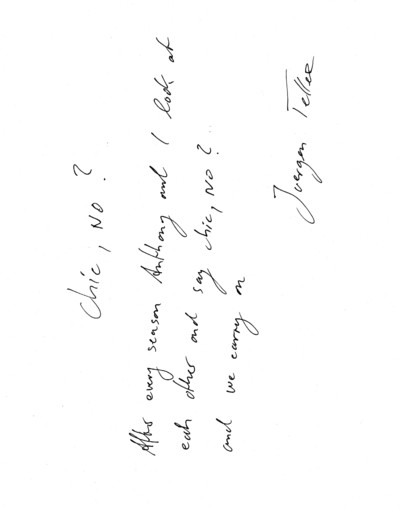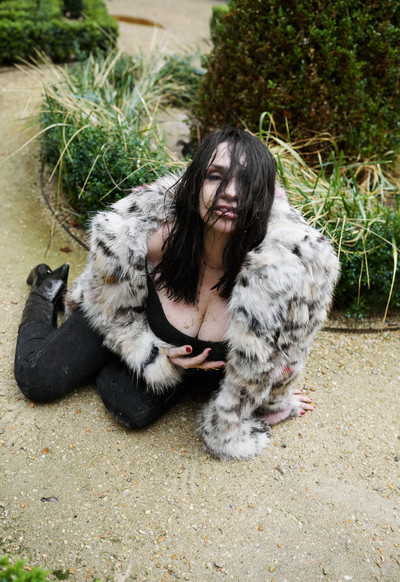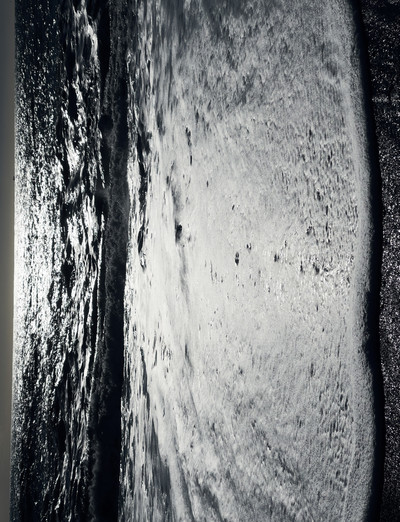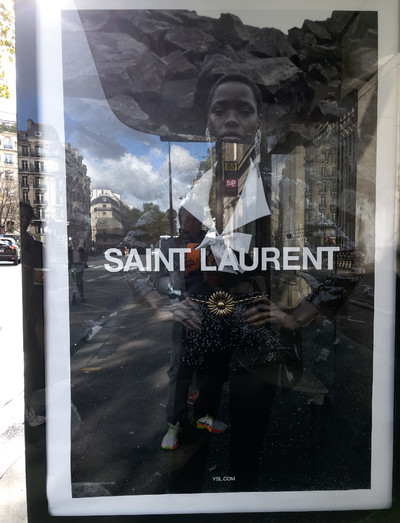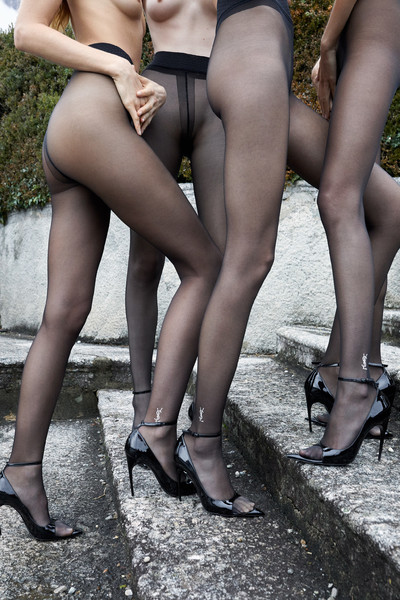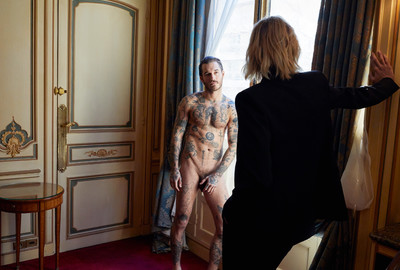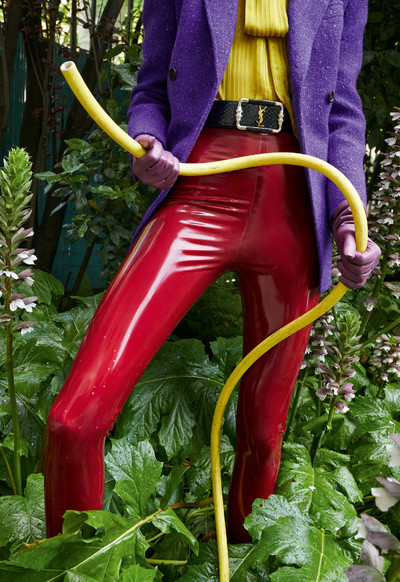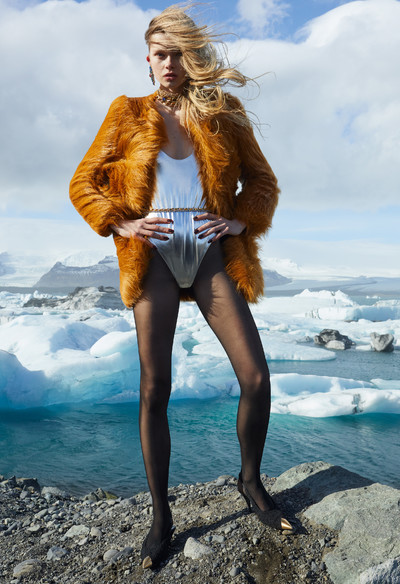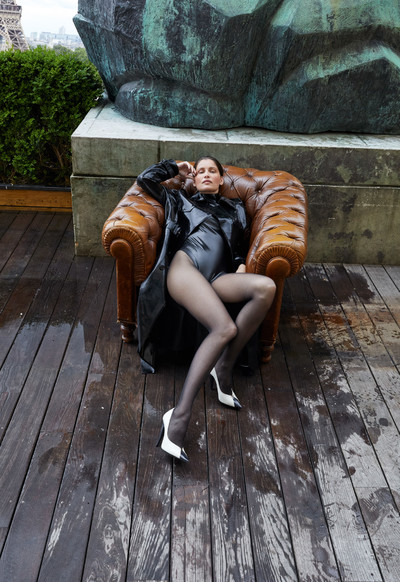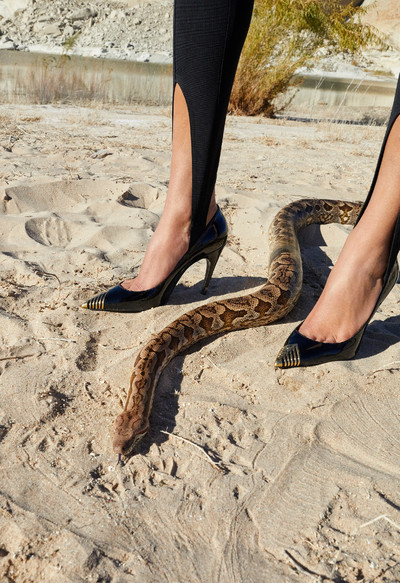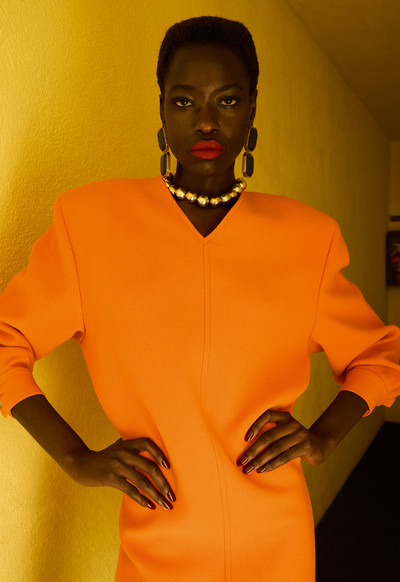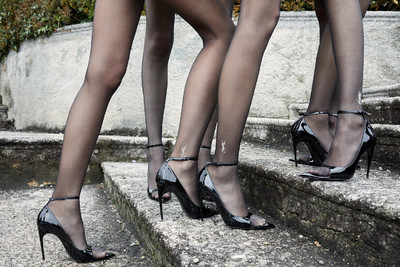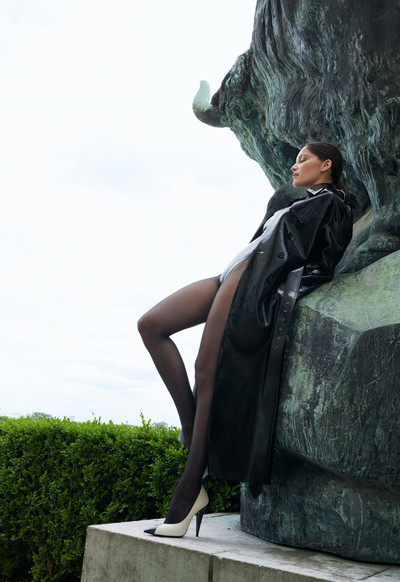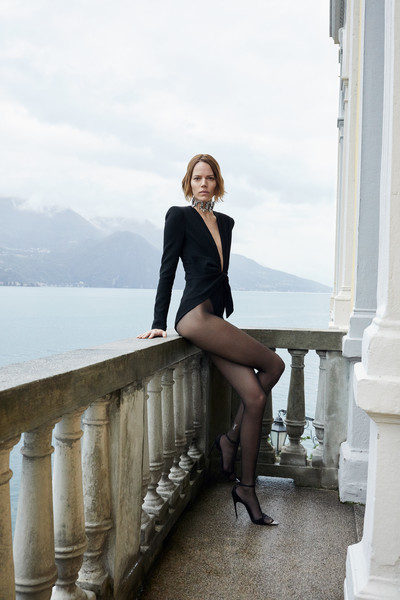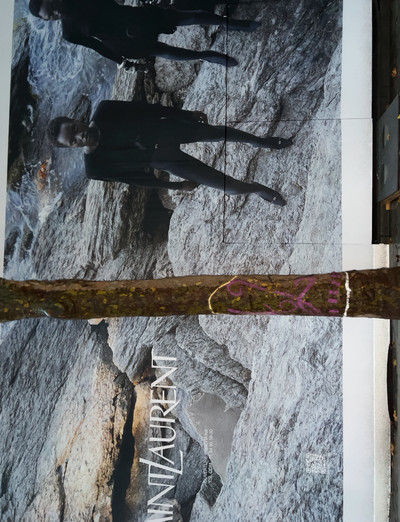Saint Laurent CEO Francesca Bellettini and creative director Anthony Vaccarello on their ‘never compromise the brand’ strategy.
Interview by Jonathan Wingfield
Photographs by Juergen Teller
Creative partner Dovile Drizyte
Saint Laurent CEO Francesca Bellettini and creative director Anthony Vaccarello on their ‘never compromise the brand’ strategy.
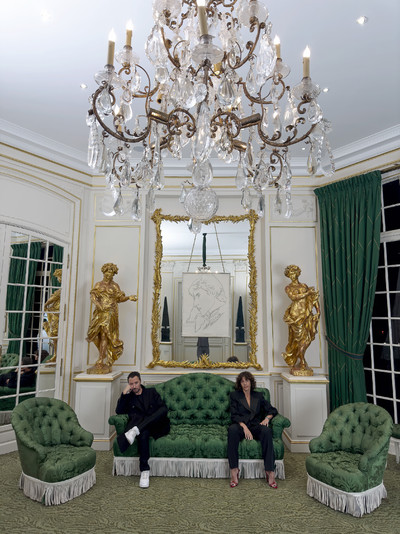
Against an economic backdrop of post-pandemic uncertainty, one thing feels reliably certain: luxury fashion just keeps growing. Of course, in today’s topsy-turvy swings-and-roundabouts industry, some hallowed houses always seem to be faring better than others, with hype, resilience and double-digit growth as common for some as scandal, musical chairs-like personnel changes and sluggish sales are for others.
For Saint Laurent though, the company’s strategy of taking ‘evolution not revolution’ to scale has made it the stealth success story of the moment. Revenue in the first half of 2022 was up 42%, with projections for the total year looking on track to surpass €3 billion.
While business analysts are quick to highlight category-led collections and healthily geo-diversified retail expansion as the key driving factors for the growth, the duo behind the momentum, Saint Laurent CEO Francesca Bellettini and creative director Anthony Vaccarello, prefer to follow a strict, no-nonsense mantra: ‘Never ever compromise the brand.’ Which, when you have a name as alluring and storied as Saint Laurent, would seem like common sense.
Since joining the house in 2016, Vaccarello’s razor-sharp collections have put the tailoring and super-sexy front and centre, while mythologizing the Paris of Yves Saint Laurent, and re-establishing the iconic Cassandre-designed YSL logo as the symbol for ‘chic with a hint of scandal’. System caught up with Bellettini and Vaccarello
in his office in the Saint Laurent Paris HQ (situated, of course, Rive Gauche) to discuss their respective paths to success and why, sometimes, it’s best to ignore the billions.
At school, were you a straight-A student, a rebel or a slacker?
Francesca Bellettini: I was a good student and got good grades, but I also wanted to go out and have fun – I grew up in Emilia-Romagna, a region of Italy with lots of distractions. I was the one in class sharing my homework around, making sure everyone would pass, which probably says a lot about my character.
Anthony Vaccarello: At my school in Brussels, I was with the bad guys at the back of the class. We were always able to strike a deal with the one or two good students – the ones like Francesca! – who would agree to hand over their homework. I was always good at art but during my high-school years studies were more focused on Latin and mathematics. I was always interested in fashion, music and cinema, but I never imagined that I could do that as a job. When I was 18, I began studying to become a lawyer because that represented a ‘normal’ job.
Was there a moment of epiphany when you said, I have to pursue fashion?
Anthony: Yes, when I realized how much you have to study to become a lawyer! I remember thinking, ‘This is nothing like Ally McBeal.’ [Laughs] My parents saw me getting pretty depressed about the situation, and they said I should do what made me happy. I got into La Cambre [fashion school], discovered something I really loved doing, and everything changed for me.
Growing up, what was your rapport with luxury consumerism?
Francesca: My family didn’t consume luxury, but being Italian meant that we grew up aware of things like quality furniture and design. It was never a given that we’d spend money on fashion, but we still valued looking nice. I remember my mum taking me and my two sisters to the local seamstress with pictures of looks from [fashion] shows, and asking her to make them for us.
Anthony: I was always attracted to fashion and luxury, even though it was never part of my family. I worked at weekends and during the holidays to be able to buy myself things from Dior Homme. I was the only one at school dressed like that.
One-time Louis Vuitton CEO Yves Carcelle told me he was a natural-born entrepreneur, already selling marbles at school. What about you, Francesca?
Francesca: I’m more a natural-born manager than an entrepreneur. That started with my father who was an accountant; I loved going with him to his office, where he’d teach me how to write invoices. He would give me the out-of-date invoicing booklets and a stamp, and aged eight or so I’d spend my afternoons ‘selling’ everything in my bedroom! I had my little fake phone and my imaginary customers who I’d call up to say, ‘I sold you my lamp yesterday, and now I’m sending the invoice and you have pay me.’
Having started your career in investment banking in London, was entering the fashion industry something of a culture shock?
Francesca: During my last two and a half years in investment banking I actually specialized in the fashion and luxury industry. That’s how I met Patrizio Bertelli at Prada, who brought me into fashion and offered me a job. Investment banking for me was more about consulting, and when I moved into the fashion industry itself I quickly realized that giving advice is relatively easy, but the people running these companies are experiencing everyday problems that you can never identify as a consultant. My first reaction was to call my old clients and apologize for how I had made my advice sound so easy to put into practice!
‘Helmut Lang taught me very early in my career that creating something that cannot be sold is the ultimate luxury in fashion.’
Tell me about early experiences with colleagues who were purely creative.
Francesca: The first was Helmut Lang. It was fascinating to see close up how he embodied the essence of creativity, so far removed from marketing-led consumer products. I remember one time Helmut had cancelled a dress from his collection before it went into market, but then he later put that same dress in the campaign. I was freaking out, so I called him and said, ‘Look, there’s a dress in the campaign that we’re not even selling’, and he said, ‘Creating something that cannot be sold is the ultimate luxury.’ He taught me early in my career that in luxury the most important thing is to create desire.
Anthony, you’ve said that when you were at La Cambre fashion school, ‘it was the Bernhard Willhelm era – the complete opposite of what I was doing at the time, which was way more Tom Ford.’ Was Tom Ford’s influence on you purely stylistic?
Anthony: Everyone was into Bernhard Willhelm, Martin Margiela and Ann Demeulemeester, who of course I respected, too, but I was less drawn to that aesthetic. At La Cambre, the Belgian and Japanese designers were considered more art than luxury, although luxury wasn’t even a word we used – that felt more French, more Saint Laurent or Chanel. As for Tom Ford, other students thought his name was almost like an insult, but I found his collections – in particular his use of black and leather – far more appealing. Maybe because my parents were Italian, so I always had this Italian and Belgian duality in me, something sexual and seductive while still being ‘real’ clothing. Around that time, in 2001 or 2002, Tom was a total visionary, in the way he linked designing collections with creating imagery and marketing products.
Francesca: I joined Gucci around that time, and I remember being excited to see Tom Ford working, even though it was from a distance. As Anthony says, he and Domenico [De Sole] created a new way of working in fashion, between design and merchandising, and all driven through image. What they did at Gucci has obviously informed so many other brands since then.
‘The other students in my class at fashion school thought the name Tom Ford was almost an insult, but I found his collections far more appealing.’
Francesca, you worked for [current Gucci CEO] Marco Bizzarri at Bottega Veneta. What did you learn from his style of management?
Francesca: Marco is confident in his own skin so has never been afraid to hire people who are better than him in specific roles, because he understands you cannot pretend to know everything. I experienced this management style first hand and he gave me the space to be myself, and to be noticed by others – including François-Henri Pinault. By managing me, he was allowing me to be better. It was an important lesson, and when I became CEO here, I wanted to adopt a similar approach. Three industry CEOs – Emmanuel Gintzburger, who’s at Versace, Cédric Charbit [at Balenciaga] and Leo Rongone [Bottega Veneta] – were all previously part of our management team at Saint Laurent. They are incredibly talented, and I was lucky to have them on the team, but I was also happy to help them grow and to give them the possibility to be seen by others.
Francesca, you joined Saint Laurent almost ten years ago, when Pierre Bergé was still alive. Tell me about your experiences meeting with him.
Francesca: Pierre was always very sincere and said exactly what he thought, which I really appreciated, because I am the same. He’d call me to say he’d spoken to the press about how proud he was of what was happening at Saint Laurent; he’d also call me about things he didn’t like. We had a very normal and open dialogue. When Anthony was appointed as creative director, Pierre was really happy because Anthony had previously won the ANDAM award that he had created in Paris for new designers. He’d already seen Anthony’s talent for himself, and he told me, ‘You did right.’
Anthony, did you speak with Pierre Bergé at the time?
Anthony: Yes. After I was appointed at Saint Laurent, we’d have lunch together once a month at a small Japanese restaurant near Avenue Montaigne. I was always impressed by him. He was known to be pretty difficult with people he didn’t initially take to, but he was always very kind and supportive of me. Having the blessing of the person who created the house alongside Yves Saint Laurent obviously meant a lot.
Francesca: Pierre was very ill at the time Anthony did his first ready-to-wear show for Saint Laurent, but he still made the effort to come and support him, which I think says a lot.
Francesca, what was your impression of the company when François-Henri Pinault asked you to take over in 2013?
Francesca: It was immediately apparent that the brand was nowhere near the potential of the brand name. People had been working too much on the business side and not enough on the brand and the brand positioning. I focused on what I know best – business and organization – to identify with the team which quick adjustments we could make, while getting the people in the regions to start reporting directly to me. With François-Henri, we took the decision to keep investing in Saint Laurent and take it to the next level, with a focus on protecting the brand. The reality is that when Anthony joined in 2016, the company needed him in order to get to that next level, and to do so, it had to change significantly as a brand and an organization. I knew Anthony could lead that. Ultimately, we’ve been able to improve the company’s overall quality, positioning and image because Anthony has pulled us in the right direction. When we first met, the two of us discussed what we felt was right for the company, and it was the same thing – growing the business, of course, but always protecting the image, and never following others. People sometimes think the only way to grow is to do the same things as everyone else – sportswear, collaborations…
Anthony: I hate all that stuff, and I’m really proud of the fact we’ve avoided doing what other brands seem to be attracted to, simply because it’s considered cool or might unlock rapid growth. There’s absolutely no desire for us to compromise the inimitable name of Yves Saint Laurent.
Francesca: We are here as custodians, and we know that this brand will survive all of us. And I hope when people talk about this period in the house’s history, they talk about the part it’s played in the overall brand legacy, and not just about profitability.
Francesca, how has your role evolved now that Saint Laurent is reaching the €3 billion turnover mark?
Francesca: I honestly try not to feel the pressure of the size or the number of people, and I try to keep the pressure off everyone else from feeling this, too. If you thought too much about the 5,000 employees and their families who depend on you, you’d end up never taking the risks that you need to take.
Anthony: I’m the same. The last thing I want to be thinking about when I’m creating the collections is the billions associated with the brand’s sales. If I did, I’d end up designing counterintuitively. I’m happy to continue working just like I did when I first joined.
This might seem like an absurd question to ask a CEO, but is there a time when big becomes too big? When could Saint Laurent’s scale have an adverse effect on the value of the brand?
Francesca: It all goes with the positioning and the image of the brand. The interest around the Saint Laurent brand is immense, but looking at other brands, you can see which are huge – certainly bigger than us – but remain true to who they are. Then there are those that have reached certain sizes but compromised their core values. They are the ones that fall, and they’re the ones I look at to understand what we should be avoiding.
Anthony: Timing is so important in these things. For example, it will be my first men’s show in Paris in January. It took me six years to get here but I think now is the right moment.
Francesca: There was no need, from a business standpoint, for me to go to Anthony and say, please, let’s do a men’s show. It happened organically, and with this first men’s show now comes the ideal moment to push our menswear more.
Anthony: The best thing about working with Francesca is that we really understand one another.
Francesca: We talk a lot; we exchange a lot. Whenever I’ve had to take any important business decisions, Anthony is the one person I really talk to and who I trust, because I know he’ll always tell me the truth. We’re in this together.
With still so much industry-wide emphasis on the Chinese market, what do you think draws Chinese consumers to Saint Laurent?
Francesca: The fact that we don’t change who we are when we go into a market allows us to make ourselves understood wherever we are. It’s fundamental to our ‘never compromise’ strategy. I always say when we go into a market that we never localize but we do contextualize. That means I explain to you who I am in a way that you can understand – but I don’t change who I am. Today’s consumer is international and I find it disrespectful to a local market to go in and do things differently because you think they’re different. It is not true. Our Chinese customers are no different to our Western customers. Everybody thinks that China is the market for accessories – but our Chinese stores are those selling the highest share of ready-to-wear.
Francesca, you headed up the merchandising department at Gucci and later Bottega Veneta before joining Saint Laurent. What does the merchandising scenario look like here?
Francesca: The merchandising role is different in each company, because it has to adapt to the creative director you have. It is a function at the centre of the company, and its most important role is to forge a link between the creativity of the company and its peripheral production – the development, the deliveries, the stores. Anthony has had his own brand in the past and knows exactly how a collection needs to be built, so he doesn’t need exterior consultants to come in and tell him what the collection plan format and product range should look like. That’s nonsense. The moment you come into the luxury industry and try to work by format, you’re done for. It won’t work. We structure the merchandising so it can deliver Anthony’s vision into the regions in the most faithful ways. We’re not a brand that has a crazy fashion show and then a completely different product selection for the stores.
Anthony: That’s the beauty of this house. There’s no commercial spin-off between what’s in the shows and what’s in the stores. I design the collections with every category in mind – knitwear, sweaters, dresses – because I like to see those pieces in the street, worn by everyone. It’s not like I only do transparent dresses or mini dresses; it’s 360 degrees.
Francesca: That’s why today’s creative directors need to know much more about merchandising than they did in the past. They’re in charge of the entire brand image, not just designing the collection, which is why Anthony is constantly thinking about the stores, the collections, the images, the communications – it’s a complete vision.
Yves Saint Laurent started as a couture house. What are your thoughts on couture and the house today?
Anthony: It’s obviously really hard to do couture here because it was so linked to Yves Saint Laurent himself. Of course, I want to do it, but I want to do it well, and I have to feel it’s the right moment to extend that part of the brand, like with the men’s show. For me, couture is something I am already doing in the ready-to-wear, in the way some of the pieces are constructed.
Francesca: We actually still have some people working in the company who worked with Yves Saint Laurent.
How much is a house’s identity and success today tied to a designer’s presence and personality?
Francesca: One hundred percent. That is why you have to be able to choose the person who is right for the house. It is not true that one designer fits all. The worst thing is when you try to force someone who has an aesthetic that has nothing to do with the positioning of the brand. And it is very important that the creative director has a genuine love for the brand; otherwise it won’t last. It’ll just be a big revolution followed by rebuilding everything up again. As Anthony often says, he feels like he is creating for himself when he is creating for Saint Laurent. It’s a natural match.
‘For me, this is not a job. I don’t wake up and think, ‘Oh, I have to go to the studio’; I live and breathe it every day. When I stop, I get sick.’
Francesca, it feels depressing to have to ask this, but nonetheless important – you’re practically the only female CEO of a major fashion house. Why?
Francesca: Honestly, I think that question should be asked to the people who still have a problem with it. I have always been very lucky in my life because I never felt being a woman was a disadvantage; on the contrary, I always felt it was a plus. In my family, I had two sisters, and I was never told I couldn’t run a company. So that has always been the way I lead my life. I was lucky to have this vision and then to join a group like Kering, where François-Henri Pinault puts talent first and promotes gender equality. I hope we can be an example for other successful female CEOs.
Francesca, this is maybe a tough question because he is sitting next to you, but what is Anthony’s biggest flaw?
Francesca: That’s easy. He never stops working! I go on holiday; he never does.
Anthony: But for me, this is not a job. I don’t wake up and think, ‘Oh, I have to go to the studio’; I live and breathe it every day. I’m very lucky.
Your partner in life also works in the Saint Laurent studio. Does the work conversation continue when you both go home or is there some distance?
Anthony: It never stops – and I don’t want it to stop. When I stop, I get sick.
And Anthony, what is Francesca’s biggest flaw?
Anthony: Same thing; she never stops!
